How fast do air plants grow?
Patience is crucial for growing air plants such as Tillandsia stricta because growth is always going to be slow and no amount of fertilizing can change that.
Tillandsia is the botanical name for air plants.
Air plants are part of the bromeliad family and are epiphytes according to Clemson University.
There are some things that can be done to promote flowering in air plants, which ultimately leads to pup formation and that’s when you’ll start seeing better growth.
Where air plants differ from typical houseplants in terms of the growth rate is that they don’t grow bigger in size (or at least big enough to be noticeable), but rather in numbers because each plant produces new plants.
Table of Contents
How Fast Do Air Plants Grow?
Air plants are slow-growers, only growing less than 1-inch within their first two years when grown from seed. They bloom only once, but after that, they can continue producing offsets (pups) for years. Those can continue growing in clumps indefinitely to grow a massive air plant specimen or propagate the pups to start new plants.
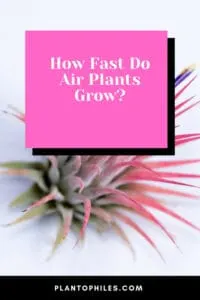
How Fast Do Air Plants Grow?
The Two Types of Air Plants
Air plants grow fastest when they’re grown in conditions that mimic their natural habitat.
- Mesic air plants grow faster in homes with higher humidity, lower-light levels. Air plants need to be watered frequently.
- Xeric air plants have adapted to desert climates so they prefer more sunlight and less watering.
Both types of air plants are slow growers, only growing under an inch in the first two years.
It can take air plants up to five years (from seedling) to bloom and reach maturity, at which point they produce pups and those can be used to grow new plants, or leave it attached to grow a bigger air plant.

Air plants only grow less than 1 inch within the first 2 years
Understanding the Growth Cycle of Air Plants
Raising air plants is much different from your average houseplant because these will only bloom once, then die. But, before they die, they produce pups.
In theory, air plants can live forever. Each bloom paves the way for new pups to form and those can be propagated to grow a new air plant from scratch.
The sooner an air plant blooms, the sooner it’ll produce pups and that’s when you’ll see growth.
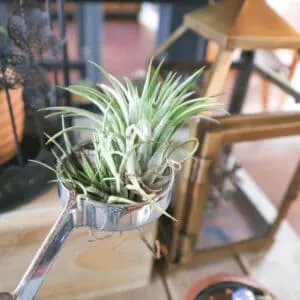
Tillandsia do not grow in size
How to Promote Flowering
Given that pups form after flowering, it stands to reason that to get the fastest growth rate, you’d want to promote flowering.
The sooner an air plant flowers, the sooner it produces pups.
You can either keep those attached to the parent plant to grow clumps together for a bigger plant or separate them to grow new plants from cuttings.
Either way, the focus for growth is on flowering.
The best way to encourage flowering is to maintain the growing conditions, which is sufficient light and regular watering.
The more light the plant gets, the faster it dries out due to the increase in temperatures.
Ideal temperatures for air plants are 50oF (10oC) to 90oF (32oC) with either bright indirect sunlight, or 12-hours of full-spectrum grow lights.
How frequently you water your air plants depends on light, temperature, and relative humidity. The hotter and drier the growing climate, the more they’ll need to be watered.
When an air plant needs a drink, the leaves curl up.
When you see that happening, dunk it in water and let it soak up what it needs, but be sure to let it drip dry to avoid crown rot.
The only time not to dunk air plants in water is when it’s flowering. The leaves on air plants won’t drown, but the flowers they produce in bloom will.
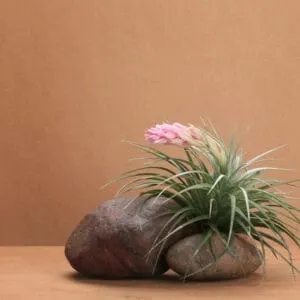
Tillandsia only bloom once
How to Promote Pupping
Once an air plant flowers, it takes up to six months for the plant to start producing offsets (pups).
The plant will only bloom once but they can continue producing offsets for years.
After each plant blooms, the flower dries up and it should be cut off along with the flower stalk as that promotes pupping – the term used for producing new air plants.
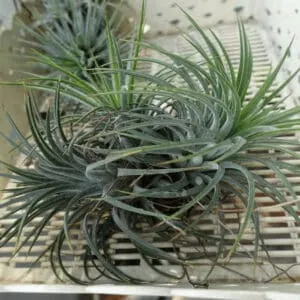
Air plants grow multiple pups and build clusters that grow larger and larger
Specially-Formulated Tillandsia or Bromeliad Fertilizer Promotes Faster Growth
Fertilizers don’t keep air plants alive. Water and sunlight do that.
What the fertilizer can help with is promoting faster growth by feeding the plant the nutrition it needs for better flowering and bud/pup formation.
Fertilizers for air plants need to be specifically for tillandsia or bromeliad plants because the nitrogen content needs to be non-urea-based so that the plants can absorb it through the leaves.
Urea-based nitrogen is reliant on soil and since air plants are soil-less plants, any fertilizer using urea will do more harm than good.
Air plants don’t need much fertilizing. Once per month during the active blooming season, which is Spring until Early winter, is sufficient.
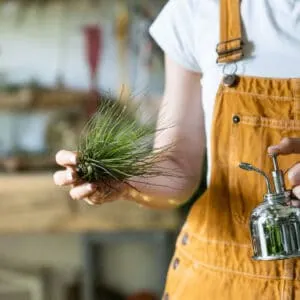
Air plants need to be watered frequently
When and How to Propagate Air Plant Pups
The pups that form are best left until they’re a third of the size of the Mother plant.
If you cut it away from the parent plant too early, it’s unlikely to grow as fast it would otherwise.
Air plants are mostly propagated through the separation of the pups.
Generally, a pup is removed when it has reached a third of the size of the Mother plant and it can bloom within a year to two-years.
Air plants can also be grown from seeds. They will take the longest, usually upwards of three to five years to mature.
Separating the pups from the parent plant can be done by cutting or gently tugging the baby plant away from the mother plant.
Using a pair of sharp pruners is recommended as it gives you more control than pulling would.
Frequently Asked Questions about How Fast Air Plant Grow
Do roots help air plants grow faster?
Air plant roots do nothing other than anchor the plant to a host, such as a tree bark. Whether or not you keep roots on the plants won’t make a difference to the growth rate. They get all their nutrients through the trichomes on their leaves.
When is the best time to water air plants?
Air plants need to be watered in the morning. Tillandsias are different from typical houseplants because they use what’s called CAM (Crassulacean Acid Metabolism) photosynthesis. This means they only ‘breathe’ at night. During the day, they stay hydrated, but the leaf pores remain closed and only open during the night. Or, if you’re using grow lights when the lights go out. Watering air plants in the afternoon or evening will mean the leaves will still be moist overnight, making it difficult for the plant to breathe. It is possible to water air plants by letting them soak overnight, but it shouldn’t be done regularly. Overnight soaking is better for reviving a dehydrated air plant, but not a watering method to use frequently.

Daniel has been a plant enthusiast for over 20 years. He owns hundreds of houseplants and prepares for the chili growing seasons yearly with great anticipation. His favorite plants are plant species in the Araceae family, such as Monstera, Philodendron, and Anthurium. He also loves gardening and is growing hot peppers, tomatoes, and many more vegetables.


